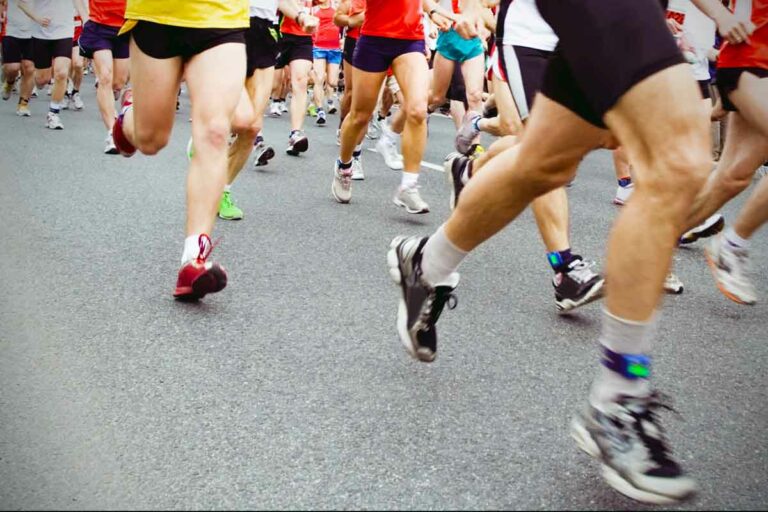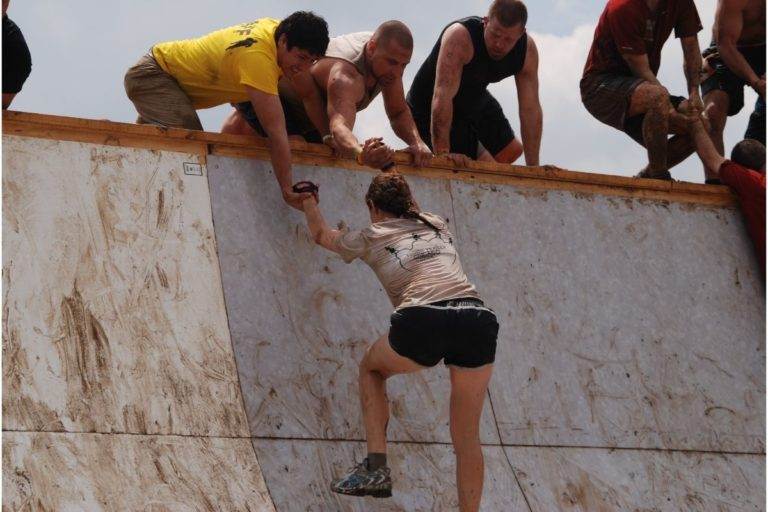How to Pee During a Marathon? (Or Can You Avoid Toilet Breaks?)

Have you ever wondered how marathon runners manage to avoid toilet breaks during a race that can last for hours?
Yes, completing a full or half marathon without restroom breaks is possible.
But this VARIES significantly from runner to runner. Some of us easily need 3-4 toilet breaks, while others can do without.
You’ll probably learn if pee breaks will be an issue when you train for a long-distance race. But when race day EXCITEMENT hits, it can MESS up all your careful preparations.
Key Takeaways: Where to Pee During a Marathon
- Portable toilets are available at various points along the race route. These are usually located at water or aid stations or designated areas.
- Planning your bathroom breaks strategically before passing these locations is recommended to minimize time loss.
- Additionally, some runners may relieve themselves discreetly in nature if necessary. However, this is generally discouraged and should be done responsibly and respectfully.
Marathon Facilities: Tips for a Smooth Race Day Experience
Marathons have portable toilets along the route, typically at the water stations.
There are also restrooms before the start and after the finish line to ensure runners can relieve themselves before and after the race.
It’s common to face long lavatory lines, especially just before the race starts.
It is good to be aware of the location of these restrooms and plan your breaks accordingly to avoid any inconvenience during the long-distance race.
Toilet Amenities: A Closer Look at Big and Small Marathons
Let’s take a look at what these big marathons say about their facilities:
- The Chicago Marathon has 20 aid stations along the course, approximately one to two miles apart. Each aid station has portable lavatories.
- The Boston Marathon has restrooms at every water and medical station and at additional locations along the course.
- The NYC Marathon has approximately 1,500 porta-potties in the start villages and the start corrals. Along the course, restrooms are located every mile from mile 3.
What about small-town races and restroom options? Well, if we look at one of the best small-town marathons, the Fargo Marathon, we can see that we are in good hands:
- Starting and finishing inside the Fargodome means real bathrooms with sinks to use before and after the race.
- Instead of grouping port-a-potties at aid stations, they’ve scattered them along the course. This seems to work, as the lines are typically short. You’ll find a porta-john every half mile or so if you need to stop for a pee.
Facilities and Wait Times at the Start of a Long-Distance Race
You may wonder if there are an adequate number of restrooms available at the start of a marathon.
- Many runners will need to use the restroom just before the race because of the race day excitement.
- Arrive early and plan accordingly to avoid typical long wait times.
- Queues are also expected at the first aid station and the first facilities after the start of a race.
- You can typically find less crowded areas along the route.

What to Do When You’re Far Away From the Designated Restroom Facilities
Here are some options to consider when you need to pee and are far from the designated facilities during a long-distance race:
- Find alternative options: Look for any nearby public restrooms, gas stations, or coffee shops that may allow you to use their facilities. It is not great for race time, but if it is needed, time will be affected anyway. It’s worth asking if there are any available options along your route.
- Look for a discreet spot: If you can’t find a loo nearby, you may need to find a discreet location to relieve yourself. Look for areas with some privacy, such as behind bushes or trees. Make sure to be respectful of your surroundings and avoid public areas.
- Portable restrooms: Some long-distance races provide extra porta-potties along the course between the aid stations. Keep an eye out for these facilities and plan your breaks accordingly.
How Do Female Long-Distance Runners Deal With the Need to Pee?
Female runners face additional challenges when nature calls compared to men if they need to pee OUTSIDE the designated areas.
Some may wear specially designed running shorts or skirts with built-in openings, which provide a more discreet way to urinate.
Others turn to female urination devices, commonly called pee funnels, as a practical solution.
Remember, it’s a common issue that many runners face, so don’t feel embarrassed or discouraged. Just do your best to manage the situation and continue with your race. And always be mindful of your surroundings and fellow runners.

What Are Some Strategies to Prepare for Toilet Breaks During a Marathon?
Some strategies for runners to prepare for pee breaks during a marathon are:
- Plan ahead: Familiarize yourself with the route and identify the locations of porta-potties along the course. Take note of where they are, and try to plan your bathroom breaks accordingly.
- Timing is key: Try to use the bathroom before the start to minimize the need for breaks during the race. Note that bathroom lines can get very long just before the race begins. And prepare yourself for the race day excitement, as it might affect how your body reacts.
- Hydrate strategically: Be mindful of your fluid intake before the race. Avoid excessive consumption of fluids right before the race to minimize the need for bathroom breaks.
- Use aid stations wisely: Take advantage of the porta-potties available at aid stations along the course. Plan your bathroom breaks around these stations to minimize time lost. Prepare for long lines at the aid stations and porta-potties at the bigger events, especially at the first aid station after the start.
- Practice during training: During your training runs, simulate race conditions by practicing bathroom breaks. This will help you develop a routine and become more comfortable with the process.
- Bring essential supplies: Carry a small pack of tissues or wet wipes in case the sanitary facilities run out. Additionally, consider bringing hand sanitizer for hygiene purposes (you never know what condition a Porta-Potty will be in when it is your time to get in it).
The Benefits of Accessible Lavatories for Runners
As a long-distance race runner, the benefits of accessible facilities include:
- Reduced Stress: Knowing facilities are available eases worries about loo breaks.
- Improved Performance: They allow for convenient lavatory breaks without disrupting your pace.
- Health and Comfort: Reduce the risk of health issues and promote comfort during the entire race, as long-distance runs may trigger stomach symptoms (runners trot).
- Enhanced Race Experience: Quality facilities create a better marathon atmosphere.
Can You Run a Marathon Without Going a Pee Break?
If you are a beginner marathon runner, it is highly unlikely that you can run a marathon or a half-marathon without needing to use the bathroom.
Long-distance running can put stress on the digestive system, and it is common for runners to experience the need to urinate or have a bowel movement during a race.
But with some experience, you learn how your body behaves, making it possible to run a long-distance race without having to stop for pee breaks. And it also helps when you get past that race day excitement.
Experienced runners are better at monitoring fluid consumption and maintaining hydration without overwhelming their bladders.
To prepare for a long-distance race without worrying about spending too much time in line at port-a-potties, follow a routine:
- Wake up early to eat, drink, and use the bathroom.
- Eat a meal 2-3 hours before running, have a sports drink 1 hour before, and drink water 30-45 minutes before the run (stick to this routine on your longer training runs to help your body adapt).
- Arrive early at the race site to beat lavatory lines. Pre-race jitters often make using the bathroom easy, and the need to go decreases as you run and sweat.
- Knowing you can use the facilities during the race eases worries. Note that the lines are usually longest at the start, not on the course.

Do Marathon Runners Pee In Their Pants?
Average marathon runners do not typically pee while running. Most races have designated porta-potties or restrooms along the course for runners to use if needed. Most of us don’t worry about losing a few minutes to visit a porta-potty.
Elite runners may not have the luxury of taking bathroom breaks during a race, as even a one-minute stop could mean the difference between winning and losing.
So, in rare cases, if an elite runner is in a time-sensitive situation and cannot afford to lose precious seconds by stopping, they may choose to urinate while running.
Another significant concern regarding the ability to manage bathroom breaks during marathon running is related to the condition of one’s pelvic muscles. Some individuals may have weakened or damaged pelvic floor muscles, affecting their ability to effectively control urinary and bowel functions.
Are There Different Facilities Break Tactics in Trail or Urban Marathons?
Loo break tactics differ between trail and urban marathons. In urban marathons, runners often rely on facilities along the course.
Ultra-distance runners and trail runners are often surrounded by nature and may not have access to traditional loo facilities. They may need to find a secluded spot behind a bush to relieve themselves.
Timing, terrain, and environmental considerations play critical roles in pee strategies for both types of races.
Frequently Asked Questions
Can You Avoid Toilet Breaks During a Marathon?
Avoiding toilet breaks during a marathon is tough, as your body may naturally need to pee while running.
What Is the Reason That Marathon Runners Stop to Pee?
Marathon runners stop to pee because they can’t hold it anymore. When you’re running for an extended period, your bladder may fill up and you will need to relieve yourself.
Is It Possible to Pee While Running?
Yes, it is possible to pee while running. Some experienced distance runners have learned to pee on the run without stopping. However, it requires practice and control over your pelvic muscles.
Is It Normal for Every Runner to Pee During a Marathon?
Yes, it is normal for most runners to need to pee during a marathon. The physical stress of running a race can stimulate the need to urinate.
Is It Common for Marathon Runners to Pee Frequently During a Race?
Yes, it is common for marathon runners to pee frequently during a race. The combination of increased fluid intake and physical exertion can lead to more frequent urination.
Can You Pee Behind a Tree During a Marathon?
Yes, peeing behind a tree during a marathon is possible if you can find a secluded area. Just make sure you are not near other runners or spectators.
The Bottom Line
The key takeaway for beginner runners gearing up for their first long-distance race is clear: be prepared but stay flexible.
On race day, feeling a mix of excitement and nerves is normal. Try to embrace these feelings and use them to your advantage.
Remember that potty breaks are a natural part of the experience. Plan ahead, consider your timing, and take advantage of available facilities. Most importantly, enjoy the journey!
Runners crossing the finish line are often offered a foil blanket to prevent excessive heat loss. Some runners may find that stress-related factors from a long run lead to more frequent urination after the race. But now you have all the time.






